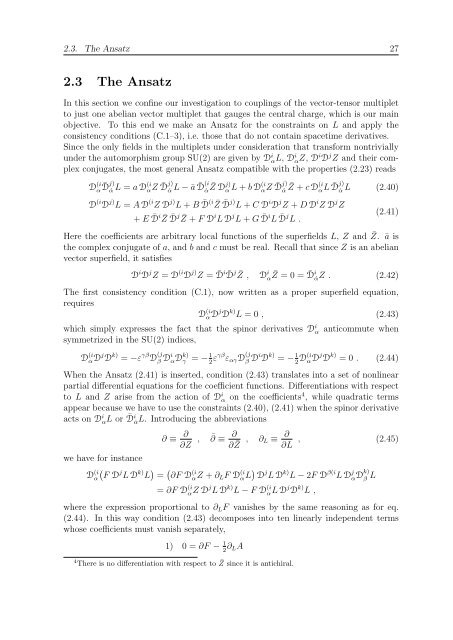N=2 Supersymmetric Gauge Theories with Nonpolynomial Interactions
N=2 Supersymmetric Gauge Theories with Nonpolynomial Interactions
N=2 Supersymmetric Gauge Theories with Nonpolynomial Interactions
Create successful ePaper yourself
Turn your PDF publications into a flip-book with our unique Google optimized e-Paper software.
2.3. The Ansatz 27<br />
2.3 The Ansatz<br />
In this section we confine our investigation to couplings of the vector-tensor multiplet<br />
to just one abelian vector multiplet that gauges the central charge, which is our main<br />
objective. To this end we make an Ansatz for the constraints on L and apply the<br />
consistency conditions (C.1–3), i.e. those that do not contain spacetime derivatives.<br />
Since the only fields in the multiplets under consideration that transform nontrivially<br />
under the automorphism group SU(2) are given by D i αL, D i αZ, D i D j Z and their complex<br />
conjugates, the most general Ansatz compatible <strong>with</strong> the properties (2.23) reads<br />
α ¯ D j)<br />
˙α L = a D(i αZ ¯ D j)<br />
˙α L − ā ¯ D (i<br />
˙α ¯ Z D j)<br />
α L + b D (i<br />
αZ ¯ D j)<br />
˙α ¯ Z + c D (i<br />
αL ¯ D j)<br />
˙α L (2.40)<br />
D (i<br />
D (i D j) L = A D (i Z D j) L + B ¯ D (i ¯ Z ¯ D j) L + C D i D j Z + D D i Z D j Z<br />
+ E ¯ D i ¯ Z ¯ D j ¯ Z + F D i L D j L + G ¯ D i L ¯ D j L .<br />
(2.41)<br />
Here the coefficients are arbitrary local functions of the superfields L, Z and ¯ Z. ā is<br />
the complex conjugate of a, and b and c must be real. Recall that since Z is an abelian<br />
vector superfield, it satisfies<br />
D i D j Z = D (i D j) Z = ¯ D i ¯ D j ¯ Z , D i α ¯ Z = 0 = ¯ D i ˙αZ . (2.42)<br />
The first consistency condition (C.1), now written as a proper superfield equation,<br />
requires<br />
D (i<br />
αD j D k) L = 0 , (2.43)<br />
which simply expresses the fact that the spinor derivatives D i α anticommute when<br />
symmetrized in the SU(2) indices,<br />
D (i<br />
αD j D k) = −ε γβ D (j<br />
β Di αD k)<br />
γ = − 1<br />
2 εγβ εαγD (j<br />
β Di D k) = − 1<br />
2 D(i<br />
αD j D k) = 0 . (2.44)<br />
When the Ansatz (2.41) is inserted, condition (2.43) translates into a set of nonlinear<br />
partial differential equations for the coefficient functions. Differentiations <strong>with</strong> respect<br />
to L and Z arise from the action of D i α on the coefficients 4 , while quadratic terms<br />
appear because we have to use the constraints (2.40), (2.41) when the spinor derivative<br />
acts on D i αL or ¯ D i ˙αL. Introducing the abbreviations<br />
∂ ≡ ∂<br />
∂Z , ∂¯ ∂<br />
≡<br />
∂ ¯ Z , ∂L ≡ ∂<br />
, (2.45)<br />
∂L<br />
we have for instance<br />
D (i<br />
j k) (i<br />
α F D L D L = ∂F D αZ + ∂LF D (i<br />
αL D j L D k) L − 2F D β(i L D j αD k)<br />
β L<br />
= ∂F D (i<br />
αZ D j L D k) L − F D (i<br />
αL D j D k) L ,<br />
where the expression proportional to ∂LF vanishes by the same reasoning as for eq.<br />
(2.44). In this way condition (2.43) decomposes into ten linearly independent terms<br />
whose coefficients must vanish separately,<br />
1) 0 = ∂F − 1<br />
2 ∂LA<br />
4 There is no differentiation <strong>with</strong> respect to ¯ Z since it is antichiral.

















